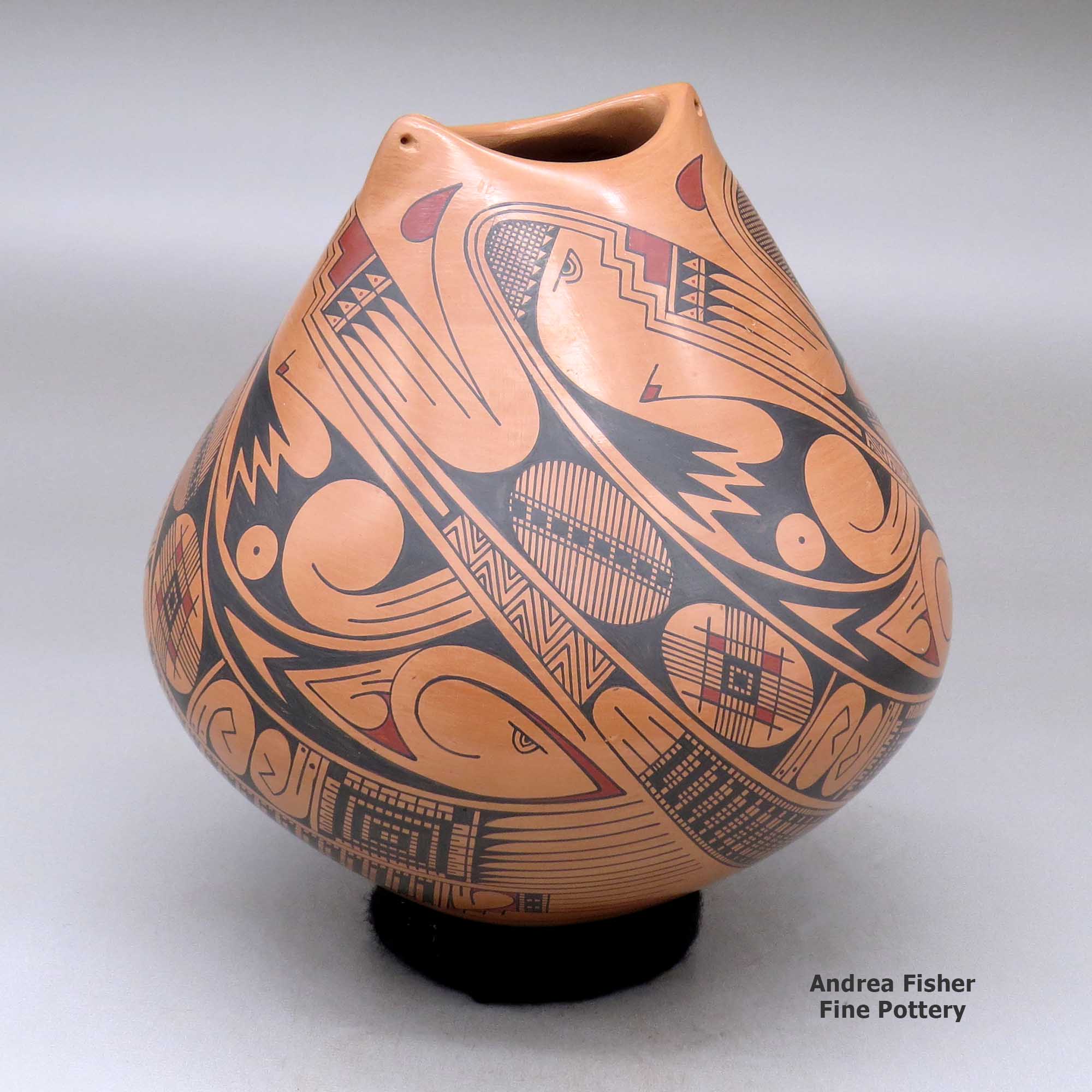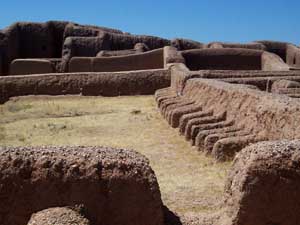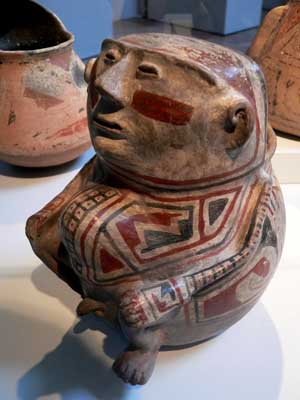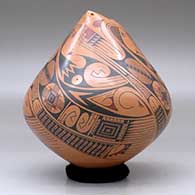
Click or tap to see a larger version
Cesar Dominguez, Mata Ortiz and Casas Grandes, A polychrome jar with an organic opening and decorated with a four-panel Paquime-style geometric design
Mata Ortiz and Casas Grandes
$ 695
mkcg4j300
A polychrome jar with an organic opening and decorated with a four-panel Paquime-style geometric design
7.5 in L by 7.5 in W by 8 in H Measurement includes stand
Condition: Very good
Signature: Cesar Dominguez
Tell me more! Buy this piece!
(505) 986-1234 - www.andreafisherpottery.com - All Rights Reserved
Cesar Dominguez
Mata Ortiz and
Casas Grande

Cesar Elias Dominguez Nuñez was born in a hospital in Nuevo Casas Grandes in June, 1961. His mother took him home to Mata Ortiz the next day and he grew up there. His first job out of secondary school was as a grade school teacher for the Chihuahua al Pacifico Railroad. He was 16. His employment contract required that he report for work, then go to school and earn the credentials necessary to do the job. He began university in Durango in 1978 and finished in Ciudad Juarez in 1981. By 1984, though, he was an established member of the first generation of Mata Ortiz potters.
Today, Cesar and Gaby Dominguez are a husband and wife team of potters living in Nuevo Casas Grandes. They moved there for Cesar's job as a schoolteacher and because there were better schools available for their kids. Like many husband and wife teams, she builds and polishes the pots and he sands, paints and fires them.
Their repertoire is large, running the gamut from differently colored, intricately decorated stone-polished ollas to plates, bowls and marbleized pottery. Their decorating style is equally varied, with painted images of various animals, fineline geometric designs and Paquimé Revival patterns. They have been particularly successful in painting bright geometric designs on glossy black graphite backgrounds.
Cesar and Gaby traveled to the Idylwild Arts Academy in California for several years to continue giving the summer pottery workshops that Juan Quezada Sr. used to give there. In 2018 Cesar won the First Place prize in the New Properties division at the annual Concurso Ceramica de Mata Ortiz. In 2017 he'd won a First Place prize in the Non-traditional Color category, with or without design, at the Concurso.
Mata Ortiz and Casas Grandes

The macaw pens at Paquimé
Casas Grandes is both a municipality and an archaeological district in northern Chihuahua State, Mexico. The archaeological district includes the pre-historic ruins of Paquimé, a city that began to build around 1130 AD and was abandoned about 1450 AD. Archaeologists are uncertain as to whether Paquimé was settled by migrants from the Mogollon/Mimbres settlements to the north or by Anasazi elite from the Four Corners region in the United States or by others. Over the years Paquimé was built into a massive complex with structures up to six and seven stories high with multiple Great Houses in the surrounding countryside. Today, the site is a UNESCO World Heritage Site.
Mata Ortiz is a small settlement inside the bounds of the Casas Grandes municipality very near the site of Paquimé. The fortunes of the town have gone up and down over the years with a real economic slump happening after the local railroad repair yard was relocated to Nuevo Casas Grandes in the early 1960's. The town was in steady decline until Juan Quezada, a poor farmer who gathered firewood in the area of the archaeological site, was inspired by fragments of ancient Paquimé pottery and even older fragments of Mimbres forms with bold black-on-white designs littering the ground to learn more.

Ramos Polychrome effigy pot from Paquimé
Quezada was successful in his quest to learn to recreate the ancient process using slightly more modern techniques (although no one in the present tradition uses a potter's wheel). He learned to use sand and other coarse materials for temper. He discovered that dried cow dung made an excellent and inexpensive firing fuel. Instead of using gourds for smoothing he substituted broken hacksaw blades. Instead of using yucca fiber brushes for painting he learned to make brushes with human hair. He persevered in his efforts and by 1971 had produced a kind of polychrome pottery. Since then, most pottery-making in the area has used innovations in the design and decoration of the pots but the materials and the basic crafting of the process have remained the same.
By the mid-1970s, Quezada had attracted a significant number of traders and his work was becoming a commercial success. That is when he began teaching his techniques to his immediate family. They in turn taught other family members, friends and the younger generations. Both women and men were included from the beginning.
Originally called Casas Grandes pottery in the early years of its production, the potters of this tiny village have made such an impact on the pottery communities, including many awards and special recognition from the Presidents of Mexico, that Mata Ortiz pottery is now becoming known around the world.
Today, pottery production has changed the village in many ways as there is now electricity, plumbing, vehicles and more for the residents. Virtually everyone in the small town (2010 population: 1,182) makes their living by working in some part of the pottery-making process, from potters to clay-gatherers to firewood collectors to traders.
Mata Ortiz pottery incorporates elements of contemporary and prehistoric design and decoration, and each potter or pottery family produces their own distinctive, individualized ware. Young potters from surrounding areas have been attracted to the Mata Ortiz revival and new potting families have developed while the art movement continues to expand. Without the restraints of traditional religious practices or gender constraints, a vibrant flow of new ideas has enabled the pottery of Mata Ortiz to avoid the derivative repetition common to virtually all folk art movements. This blend of economic need, gender equality, cultural expression and artistic freedom has produced a unique artistic movement in today's community.

Lower photo is courtesy of David Monniaux, Creative Commons Attribution-Share Alike 3.0 Unported License
Copyright © 1998-2025 by



